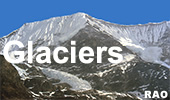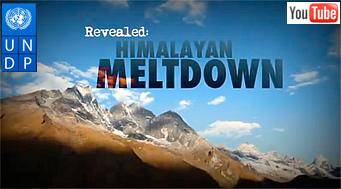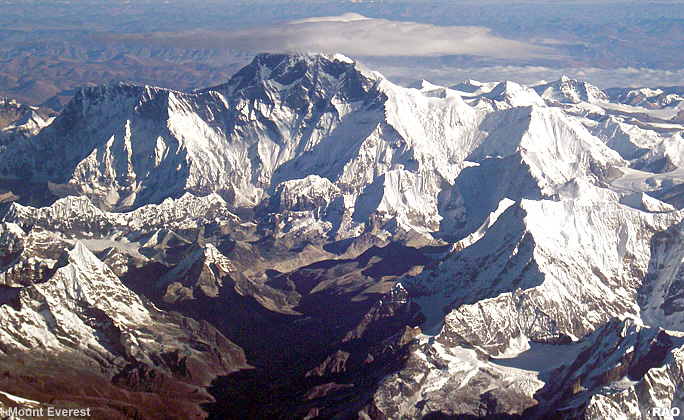| Bhutan's
glaciers and glacial lakes |
 |
Bhutan Glaciers - Glacial Lakes |
|
 |
Bhutan Glaciers - Glacial Lakes |
|
|
 |
|
Himalayas - The Himalayan Meltdown
|
|
Shrinking glaciers to disrupt billions in Asia, new documentary shows
|
 |
More than 50,000 glaciers are rapidly shrinking in the Himalayan mountain region threatening billions of lives and livelihoods throughout Asia, according to a new documentary that premiered in New York.
"I often lose sleep, scared for my community because a glacial flood would devastate the entire river valley," said Sonam Ishi Sherpa, a hotel owner in Nepal who has lived all his life at the foot of the Himalayas.
Revealed: Himalayan Meltdown, now airing on Discovery Channel Asia, examines how communities in Bangladesh, Bhutan, China, India and Nepal seek to adapt to their shrinking mountain habitat which contains 40 percent of the earth's fresh water and is a critical source for irrigation, drinking water and energy to some 1.3 billion people.
The documentary shows lakes like Imja, in eastern Nepal, which did not exist before 1960 but are now filled with glacial meltwater. Imja is one of thousands of recently formed high-altitude glacial lakes in the Himalayas that risk flooding triggered by avalanches and earthquakes.
In Nepal, climate change is not only melting the Himalayan, it is also leading to drought, as shown in the documentary. Many communities have seen seasonal monsoon rains disappear. One of the solutions helping villagers adapt is the use of low-cost moisture-trapping nets that convert fog into drinking water.
"Developing countries are more vulnerable to the impacts of climate change, but are less able to afford to adapt to it," said Helen Clark, head of the United Nations Development Programme, at the screening of the film at the Asia Society. "For them, the future is now - they must already today adapt to the changing climate and prepare for an uncertain tomorrow."
In the Kingdom of Bhutan, while harnessing Himalayan meltwater through hydroelectric dams, providing much needed energy to millions, the Government has also partnered with UN agencies - including UNDP - to avert the risk of glacial flooding from lake Thorthormi, in the country's north-central region.
The partnership - also including the Global Environment Facility, World Wildlife Fund and the Government of Austria - is hiring and training 350 workers to clear rubble from a channel that drains Thorthormi.Another 220 villagers are transporting 60 tons of material between areas lacking easy accessibility.
In addition, Bhutan is also installing early warning systems along rivers to ensure its people and infrastructures are prepared for glacial flood.
"Our project not only helps villagers buy food and education for their families; it also buys time," said Karma Toeb, Glaciologist at the Bhutan Department of Geology and Mines.
"We hope that this film will help stimulate a stronger international response to the challenges of climate change," Clark said. "Quality research, technology transfer, and increased climate finance can all help developing countries in Asia and elsewhere to adapt and adjust to the change which is happening now."
The 45-minute documentary was co-produced by the UNDP and Arrowhead Films.
| Source:
United Nations Development Programme UNDP June 2011 |
 |
|
UNDP Video
|
 |
 |
| VIDEO |
The Himalayan Meltdown |
 |
 |
External
link |
|
top
|
"Revealed: The Himalayan Meltdown" - Opening Remarks by Helen Clark
|
 |
|
Administrator of the United Nations Development Programme UNDP
|
This documentary takes us on a two thousand kilometer journey, beginning high in the Himalayas. It addresses a topic which affects all of us - the impacts of climate change on people's lives, communities, and societies.
We will hear about research on the retreat of the Himalayan glaciers, and how that impacts on the countries which depend on them and their snow pack for seasonal meltwater for irrigation, energy, and household and livelihood uses.
We will see the impact on the Asian river valleys flowing from the Himalayas - the mudslides from the shifting monsoon rains, the changing mountain terrain, and new areas of drought - all posing considerable risk to human life and to the wellbeing of more than a billion people.
This film shows how people's lives are already being affected by shifts in ecosystems, including by more extreme weather conditions. It also shows the ingenuity and resourcefulness of the communities facing these challenges.
Developing countries are more vulnerable to the impacts of climate change, but are less able to afford to adapt to it.For them, the future is now - they must already today adapt to the changing climate and prepare for an uncertain tomorrow.
This film offers some examples of how the countries and communities affected by the Himalayan glacier melt are responding to the problems.
It shows how Bhutan is reducing the emerging risk of glacial lake outburst floods; how Bangladesh is protecting its vulnerable coastlines with mangroves; and how some regions in India and Nepal are harvesting freshwater from fog and artificial ice bodies.
But more needs to be done with the support of the international community. For example:
- greater financial support is needed for adaptation, disaster early warning systems, climate change research and modeling, and the transfer of green technologies;
- specifically, the Himalayan research institutions need adequate financial support to carry out important long-term assessments; and
-while international climate change models and scenarios capture global warming trends on a broad scale, they do not adequately project the local risks which materialize in river basins and mountain valleys. For better modeling of changing risk patterns, larger networks of weather stations and stronger networking and co-operation within and beyond the region are essential.
The glacial melt in the Himalayas is only one of the effects of climate change in Asia. People in the low lying areas of the Mekong Delta have concerns about rising sea levels and greater salinity in their soils and groundwater. Other countries, such as Laos and Cambodia, are experiencing both longer dry spells and heavier rainfall, causing flood risk and erosion.
UNDP hopes that this film will help stimulate a stronger international response to the challenges of climate change. Quality research, technology transfer, and increased climate finance can all help developing countries in Asia and elsewhere to adapt and adjust to the change which is happening now.
Enjoy the film!
| Source:
United Nations Development Programme UNDP June 2011 |
 |
top
|
Information
|
 |
 |
 |
External
links |
|








